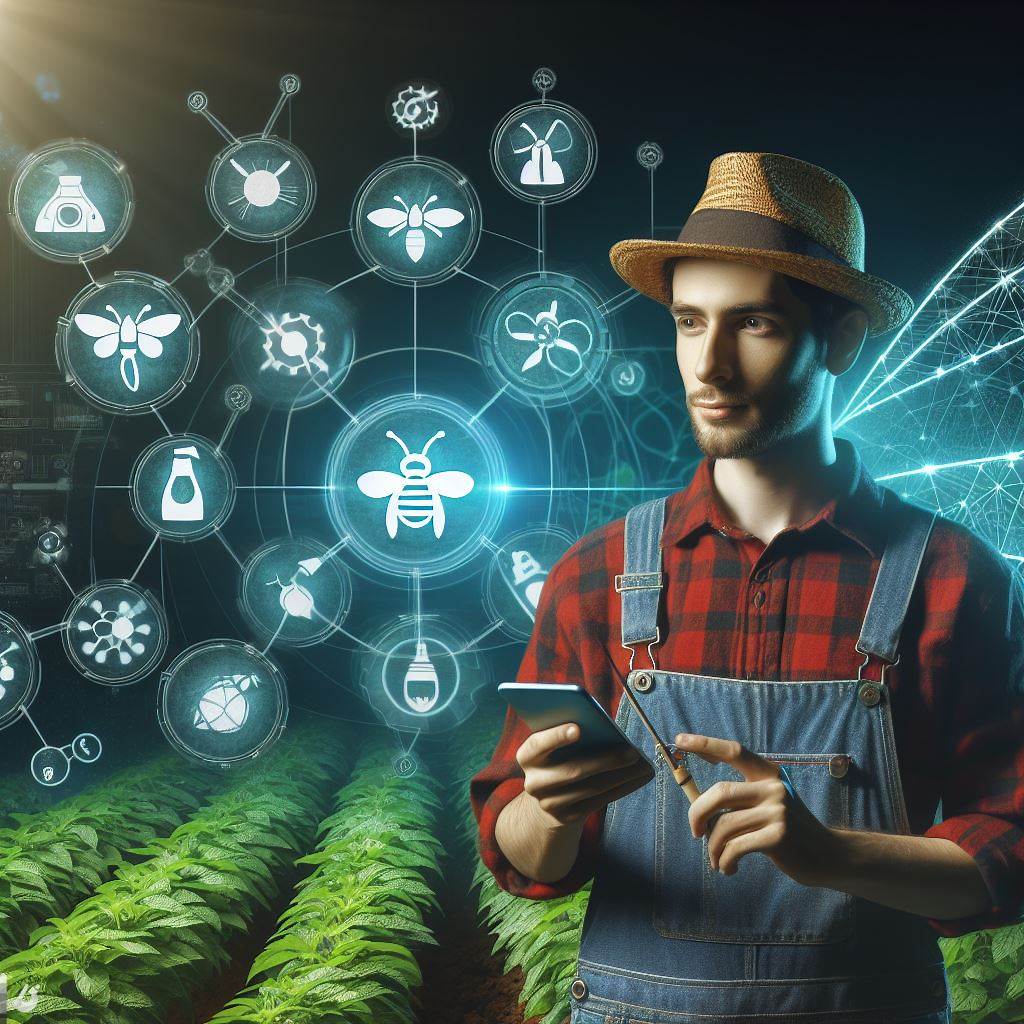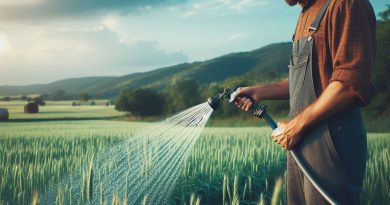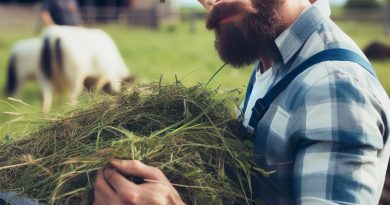Tech in Pest Control: Efficient Crop Protection
Last Updated on March 2, 2024
Introduction
In modern agriculture, safeguarding crops, especially with the integration of Tech in Pest Control Crop Protection, is paramount..
Technology catalyzes a paradigm shift, revolutionizing pest control methods.
Pests threaten food security, jeopardizing global agricultural stability.
Technology’s intervention emerges as a game-changer in this critical domain.
Emerging technologies like precision agriculture and AI-driven monitoring systems provide real-time insights.
These advancements empower farmers to anticipate and counter potential pest threats promptly.
Efficient crop protection isn’t just a necessity; it’s an economic imperative.
Technology streamlines the process, minimizing the use of harmful chemicals and reducing environmental impact.
The significance of resilient pest control methods becomes evident in the face of climate change challenges.
Technology ensures adaptability, enabling farmers to respond dynamically to evolving pest patterns.
This section explores the pivotal role technology plays in fortifying crop protection.
From sensor-based traps to drone-assisted surveillance, innovation safeguards yield, fostering a sustainable and secure agricultural future.
Traditional Pest Control Methods
Overview of conventional practices used in pest control
- Chemical pesticides have been widely used in agriculture for decades.
- Farmers rely on spraying these pesticides to protect their crops from harmful insects.
- These pesticides work by killing or repelling pests, preventing damage to the crops.
- Another common method is the use of traps to catch and control pests in specific areas.
- Traditional practices also involve the use of natural predators like birds and insects to control pests.
The limitations and challenges of traditional methods
- Environmental concerns arise due to the widespread use of chemical pesticides.
- These pesticides can accumulate in soil and water, leading to long-term harmful effects.
- Continuous use of chemical pesticides can result in the development of pesticide-resistant pests.
- Insects may evolve and become less susceptible to pesticides over time.
- The overuse of chemical pesticides can disrupt the natural ecosystem balance.
- Traditional methods may not be effective against certain pests that have developed resistance.
- The cost of chemical pesticides can be high, putting a financial burden on farmers.
- Chemical pesticides can also pose a risk to human health if not handled properly.
- The use of traps in traditional methods can be labor-intensive and time-consuming for farmers.
- The reliance on natural predators can be unreliable as they may not be effective in controlling all pests.
In closing, traditional pest control methods have been the go-to approach for farmers to protect their crops.
However, these methods come with limitations and challenges.
Chemical pesticides, although effective initially, can have harmful long-term effects on the environment and human health.
Additionally, pests can develop resistance to these pesticides, making them less effective over time.
The use of traps and natural predators also has its limitations, being labor-intensive and inconsistent in controlling all types of pests.
As technology advances, there is a need for more efficient and sustainable pest control solutions.
Technological Advancements in Pest Control
Introduction to technological advancements in pest control
- With advancements in technology, new tools and techniques are being developed for pest control.
- These innovative solutions aim to provide more efficient and sustainable crop protection methods.
- The integration of technology enables precision targeting, reducing the use of harmful chemicals.
Specific technological advancements and their benefits
- Remote sensing and drones allow farmers to monitor their fields remotely, identifying pest hotspots.
- This data-driven approach helps farmers make informed decisions and apply pesticides only when necessary.
- Automated systems, such as robotic sprayers, provide precise application of pesticides, minimizing wastage.
- Integrated Pest Management (IPM) systems use a combination of techniques and tools to control pests.
- IPM includes biological controls, crop rotation, and habitat modification, reducing chemical reliance.
- Biotechnology plays a role in developing pest-resistant crop varieties, reducing the need for pesticides.
- Genetic engineering can introduce natural pest resistance genes into crops, making them more resilient.
Overall, technological advancements in pest control offer promising solutions to the limitations of traditional methods.
These advancements not only improve efficiency but also promote sustainability and reduce the environmental and health risks associated with chemical pesticides.
With the integration of remote sensing, drones, robotic sprayers, and IPM systems, farmers can better protect their crops while minimizing the negative impacts on ecosystems and human health.
As technology continues to evolve, the future of pest control in agriculture looks promising, providing more efficient and eco-friendly solutions for crop protection.
Read: Best Soil Types for Growing Wheat: An Overview
The Rise of Technology
Introduction to the application of technology in agriculture
Technology has revolutionized various industries, including agriculture, enabling farmers to achieve efficient crop protection.
Pioneering advancements in pest control have significantly transformed traditional farming practices.
1. Drones for aerial surveillance
Drones equipped with high-resolution cameras have become an invaluable tool for farmers, aiding in the early detection of pests.
Their ability to cover large areas quickly allows for timely intervention.
2. Remote sensing and satellite imagery
Sophisticated technology now enables farmers to gather essential data using remote sensing techniques and satellite imagery.
This data helps identify areas affected by pests, facilitating targeted pest control measures.
3. Automated irrigation systems
Automated irrigation systems have proven beneficial in minimizing water wastage and optimizing crop health.
Intelligent sensors detect crop moisture levels, ensuring precise watering only when necessary.
4. Smart scouting applications
Incorporating smart scouting applications allows farmers to regularly monitor their crops for signs of pests or diseases.
Real-time updates enable prompt action, reducing the risk of extensive crop damage.
The advancements that have led to efficient pest control
The integration of technology into pest control practices has resulted in significant advancements.
These developments have revolutionized the way farmers protect their crops from pests.
1. Precision spraying systems
Modern pest control mechanisms, such as precision spraying systems, have enhanced the accuracy of pesticide application.
This targeted approach minimizes the use of chemicals, reducing environmental impact.
2. Integrated pest management systems
Technology has facilitated the implementation of integrated pest management systems.
By combining multiple strategies, such as biological control and pest-resistant crops, farmers can effectively curb pest populations.
3. Automated pest monitoring and detection
Automated pest monitoring systems utilize sensors and data analysis to detect pest presence accurately.
This real-time information allows farmers to act promptly and apply suitable interventions.
4. Predictive analytics for pest outbreaks
Predictive analytics uses historical data and advanced algorithms to predict pest outbreaks accurately.
Early warnings enable farmers to take preventive measures, mitigating potential crop losses.
The benefits of incorporating technology in crop protection
Embracing technology in crop protection offers numerous benefits to farmers, enhancing their productivity, sustainability, and profitability.
1. Increased efficiency and productivity
Technological tools streamline farming processes, increasing efficiency and improving overall productivity.
Farmers can save time and resources while achieving better crop yields.
2. Reduced reliance on pesticides
Incorporating technology allows farmers to adopt more sustainable pest control practices, minimizing reliance on harmful pesticides.
This approach promotes ecological balance and safeguards human health.
3. Cost-effective solutions
While initial technology investments can be significant, the long-term benefits outweigh the costs.
By utilizing advanced pest control techniques, farmers can save money by reducing pesticide usage and crop losses.
4. Environmental sustainability
Technology-driven pest control practices prioritize environmental sustainability.
By reducing pesticide applications, farmers minimize the impact on ecosystems, promoting biodiversity and soil health.
5. Enhanced data-driven decision-making
The integration of technology provides farmers with accurate and real-time data for decision-making.
This information enables informed choices regarding pest control strategies, improving crop protection outcomes.
Basically, the application of technology in agriculture has revolutionized pest control practices, leading to efficient crop protection.
Advancements in aerial surveillance, remote sensing, and smart scouting applications have significantly improved pest detection.
Precision spraying systems, integrated pest management, and predictive analytics have enhanced pest control effectiveness.
The benefits of incorporating technology include increased efficiency, reduced pesticide reliance, cost-effectiveness, environmental sustainability, and data-driven decision-making for optimal crop protection.
Embracing technology is vital for the future of agriculture, ensuring the efficient and sustainable production of crops.
Read: Tomato Cultivation: Tips for a Healthy Crop
Drones in Pest Control
Use of Drones for Monitoring and Spraying Crops
Drones are becoming increasingly popular in the field of pest control due to their versatility and efficiency.
They can be equipped with high-resolution cameras and sensors to monitor crops for signs of pest infestations.
Drones can cover large areas quickly and provide real-time data on the health and condition of crops.
In addition to monitoring, drones can also be equipped with sprayers to apply pesticides to targeted areas.
The precision and accuracy of drones ensure that pesticides are applied only where necessary, reducing waste.
With their ability to fly at different altitudes and speeds, drones can effectively combat pests that threaten crops.
Advantages of Using Drones in Terms of Precision and Cost-effectiveness
Using drones in pest control offers several advantages, particularly in terms of precision and cost-effectiveness.
Traditional methods such as manual spraying can be time-consuming and imprecise, leading to excessive use of pesticides.
Drones, on the other hand, can precisely target affected areas, reducing the amount of pesticides needed.
This not only helps in minimizing the impact on the environment but also saves farmers money by reducing pesticide costs.
Drones can also be programmed to follow a predetermined flight path, ensuring thorough coverage of the entire field.
By eliminating the need for human operators, drones further reduce labor costs, making them cost-effective.
Case Studies and Success Stories of Using Drones in Pest Control
Many case studies and success stories highlight the effectiveness of using drones in pest control.
One such case study involved a vineyard in California that used drones equipped with thermal cameras to detect pests.
The drones were able to identify areas of the vineyard with higher pest activity, allowing targeted pesticide application.
This resulted in a reduction in pesticide use, saving the vineyard both time and money.
In another success story, a farmer in Australia used drones to monitor and spray his crops, reducing pest damage significantly.
The farmer reported increased crop yields and reduced pesticide expenses, demonstrating the advantages of using drones.
Generally, drones have proven to be valuable tools in pest control and crop protection.
Their ability to monitor crops, target specific areas for spraying, and reduce pesticide use makes them highly efficient.
The precision and cost-effectiveness offered by drones make them an attractive option for farmers.
Numerous case studies and success stories further validate the benefits of using drones in pest control.
As technology continues to advance, it is expected that drones will play an even larger role in efficient crop protection.
Read: Irrigation Methods for Rice: Maximizing Yield

AI and Machine Learning in Pest Management
Introduce the concept of AI and machine learning in agriculture
- Artificial intelligence (AI) and machine learning have revolutionized various industries, including agriculture.
- In agriculture, AI refers to the development of computer systems that can perform tasks requiring human intelligence.
- Machine learning, a subset of AI, enables computers to learn from and analyze large amounts of data.
The potential of AI and machine learning in predicting and preventing pest outbreaks
- AI and machine learning can be employed to predict and prevent pest outbreaks in crops.
- These technologies can analyze various factors to identify patterns and potential pest threats.
- By studying historical data, AI systems can anticipate pest outbreaks and suggest preventive measures.
- Machine learning algorithms can continuously improve predictions by incorporating new data and refining models.
- Real-time monitoring through AI can alert farmers about potential threats, allowing for timely interventions.
The benefits of using AI and machine learning algorithms for enhanced crop protection
- Enhanced crop protection is one of the major benefits of incorporating AI and machine learning.
- AI systems can monitor crop health indicators, including temperature, humidity, and leaf discoloration.
- These indicators help detect early signs of pest infestation, enabling quick interventions.
- Machine learning algorithms can also analyze satellite imagery to identify pest-prone areas in large fields.
- Through predictive models, farmers can optimize pesticide usage and reduce environmental impact.
- AI can also assist in species recognition, helping to distinguish between harmful and beneficial insects.
- Automating pest identification reduces manual labor and speeds up response time.
- AI-powered robotic systems can target specific pests, minimizing indiscriminate use of pesticides.
- Precision agriculture techniques, integrating AI, lead to reduced chemical inputs and economic savings.
- AI-driven decision-making ensures prompt actions and minimizes crop losses due to pest damage.
AI and machine learning have immense potential in modern pest management
- These technologies can predict and prevent pest outbreaks, ensuring efficient crop protection.
- By analyzing large datasets, AI can provide valuable insights to optimize pest management practices.
- Enhanced crop protection, reduced chemical usage, and economical benefits are some of the advantages.
- As AI continues to advance, its integration in agriculture promises a sustainable and productive future.
With AI and machine learning, agriculture can conquer pest challenges and secure global food production.
Read: Pest Control in Corn Fields: Effective Strategies
Internet of Things (IoT) and Sensors in Pest Control
Agriculture plays a vital role in ensuring food security and economic growth.
However, pests pose a significant threat to crops, resulting in substantial yield losses and financial burdens for farmers.
Traditional pest control methods have limitations in terms of accuracy and efficiency, making it crucial to explore innovative technologies.
The integration of Internet of Things (IoT) and sensors in pest control has emerged as a promising solution.
Role of IoT and Sensors in Pest Monitoring and Detection
IoT refers to the interconnected network of devices, vehicles, and other objects embedded with sensors and software that enable them to collect and exchange data.
The use of IoT devices and sensors has revolutionized pest monitoring and detection in agriculture.
By deploying IoT devices and sensors in fields, farmers can gather real-time data on various environmental factors that influence pest populations.
These sensors can detect changes in temperature, humidity, soil moisture, and even pest behavior.
Such data allow farmers to make informed decisions in a timely manner.
Moreover, IoT devices can be equipped with automated pest traps and pheromone dispensers, significantly improving the accuracy of pest monitoring.
These traps capture pests and send alerts to farmers when pest populations exceed a certain threshold, enabling swift action to mitigate the damage.
Advantages of Real-Time Data Collection and Analysis
The ability to collect and analyze real-time data is one of the key advantages of using IoT and sensors in pest control.
Traditional methods involve manual data collection, which is time-consuming and prone to errors. However, with IoT-enabled sensors, data collection becomes automated and continuous.
Real-time data collection allows farmers to detect pest outbreaks at their early stages, preventing significant crop damage.
It provides insights into pest behavior patterns and helps identify factors contributing to pest infestations, such as favorable environmental conditions.
Farmers can then implement targeted control measures, minimizing the use of chemical pesticides and reducing environmental impacts.
Furthermore, real-time data analysis enables predictive pest modeling, which helps farmers anticipate potential pest threats based on historical data and weather patterns.
This proactive approach allows for preventive actions, saving crops and resources.
Examples of IoT Applications and Sensor Technologies
Several IoT applications and sensor technologies have been developed to enhance crop protection and pest control:
- Remote sensing drones equipped with hyperspectral cameras can identify stressed crops and potential pest damage.
- Soil moisture sensors provide valuable information for precise watering and irrigation, preventing water wastage and reducing pest habitat.
- Pheromone-based monitoring systems use IoT devices to detect and trap pests using their sexual attractants.
- Infrared sensors detect temperature variations, helping identify warm spots that may indicate pest infestations.
- Wireless insect monitoring systems enable real-time tracking of pest populations and provide early warnings for prompt action.
In short, the integration of IoT and sensors in pest control revolutionizes crop protection by enabling real-time data collection, analysis, and proactive decision-making.
Farmers can monitor and detect pests more accurately, leading to efficient pest management strategies.
The advantages of IoT applications and sensor technologies contribute to sustainable agriculture and a more secure food supply chain.
Challenges and Considerations
Technological advancements have brought new opportunities to pest control in agriculture.
However, integrating technology into pest control practices presents certain challenges and limitations that need to be addressed for successful implementation.
Address potential challenges and limitations of integrating technology in pest control
One of the potential challenges faced is the limited adoption of technology by farmers.
Some may be reluctant to invest in tech-driven solutions due to cost concerns, perceived complexity, or skepticism about their effectiveness.
Overcoming this challenge requires educating farmers about the benefits and long-term returns of using technology in pest control.
Demonstrating real-world success stories and financial incentives can encourage more widespread adoption.
Another challenge is related to technical issues that may arise with the use of technology.
Connectivity problems or device malfunction can disrupt pest control operations.
Ensuring reliable technical support and maintenance services are available is crucial to prevent major disruptions and meet farmers’ needs effectively.
Data privacy is a significant concern when it comes to integrating technology in pest control.
Farmers worry about the security and potential misuse of the data collected by tech solutions.
Regulatory frameworks can address these concerns, setting guidelines on data privacy, ownership, and proper use.
Farmers should have control over their data and trust that it is handled responsibly.
Compatibility issues may arise when integrating multiple technologies into pest control practices.
Farmers may need to invest in different systems, resulting in higher costs and potential difficulties in seamless integration.
It is important to establish industry standards and interoperability initiatives, enabling farmers to choose tech solutions that work together efficiently.
The need for training and education to maximize the benefits of tech-driven approaches
To maximize the benefits of tech-driven approaches, training and education play a vital role.
Farmers must understand how to operate and maintain technology devices.
They also need data analysis skills to interpret the data collected by tech systems to make informed decisions.
Proper training programs should be implemented to equip farmers with the necessary knowledge and skills.
Additionally, ongoing technical support is crucial to address any issues that farmers may encounter while using technology.
Accessible and responsive support teams can ensure that farmers continue to benefit from tech-driven approaches without significant downtime in their pest control operations.
The importance of regulatory frameworks to ensure safe and responsible use of technology
Regulatory frameworks are essential to ensure the safe and responsible use of technology in pest control.
Environmental impact should be carefully considered to minimize harm to non-target organisms and ecosystems.
Safety standards need to be established to address potential risks associated with the use of technology.
Guidelines should also promote responsible use and prevent any adverse effects on human health.
In fact, integrating technology into pest control practices brings numerous benefits, but it also poses challenges that must be carefully navigated.
By addressing potential limitations, providing education and training, and implementing robust regulatory frameworks, the agricultural industry can harness the power of technology to achieve efficient crop protection.
Learn More: Tech Advances in Crop Planting
Conclusion
Potential of Technology in Efficient Crop Protection
Technology is a formidable ally in safeguarding crops, offering innovative solutions for pest control.
- Precision and Accuracy: Modern tech provides precision, targeting pests with minimal impact on beneficial organisms.
- Early Detection: Advanced sensors and imaging tools enable early detection, preventing widespread pest infestations and minimizing crop damage.
- Data-Driven Decisions: The power of data allows farmers to make informed decisions, optimizing pest control strategies for maximum effectiveness.
- Automation Advantages: Automated systems, such as drones and smart traps, enhance monitoring and response, ensuring timely interventions.
- Resilient Crops: Genetic engineering, supported by technology, develops crops resistant to pests, bolstering agricultural resilience.
Embracing Technological Advancements in Agriculture
The significance of embracing these technological strides in agriculture cannot be overstated.
- Competitive Edge: Farmers adopting tech-driven pest control gain a competitive edge, ensuring healthier crops and improved yields.
- Sustainability Impact: Technology minimizes the need for chemical interventions, promoting environmentally sustainable pest management practices.
- Efficiency and Cost-Effectiveness: Automated systems streamline processes, reducing labor and resource costs while maximizing efficiency in pest control measures.
- Global Food Security: Embracing technology safeguards food production, contributing to global food security in the face of evolving pest challenges.
Encouraging Further Research and Adoption of Tech-Driven Pest Control Methods:
To propel agriculture forward, continued research and widespread adoption of tech-driven pest control methods are essential.
- Research Investment: Support and invest in research to unlock new technologies, ensuring continuous innovation for effective pest control.
- Knowledge Sharing: Facilitate knowledge-sharing platforms to disseminate information about successful tech implementations and best practices.
- Training Programs: Develop training programs to educate farmers on the optimal use of tech tools for pest control.
- Collaboration Opportunities: Foster collaborations between tech developers, researchers, and farmers to create tailored solutions addressing specific pest challenges.
- Policy Advocacy: Advocate for policies that incentivize the adoption of technology in pest control, creating a conducive environment for innovation.
In summary, the potential of technology in efficient crop protection is vast.
Embracing these advancements is crucial for agricultural progress.
Encouraging further research and adoption ensures a sustainable future where technology continues to play a pivotal role in safeguarding global food production.


